Scotland Housing Awards 2025
Read all the shortlisted entries into this award category, excellence in health and wellbeing, at the Scotland Housing Awards (SHA) 2025 and find out who won the award on the night.
The right to an adequate standard of housing is inextricably linked to the right to the highest attainable standard of health. The right to health is a shared and inclusive right and good quality, sustainable housing is key to fulfilling this for individuals, families and communities.
Winning project name
Building a Fairer Falkirk: Tackling Poverty to Improve Health and Wellbeing
Winning organisation
Falkirk Council
Statement of support
The challenge
One in four children in Falkirk lives in poverty, and Scottish government data shows that 40 percent of social tenants experience relative poverty after housing costs. Falkirk Council provides high-quality housing to over 16,000 tenants. That means around 6,400 of these households are struggling to afford essentials like food and utilities.
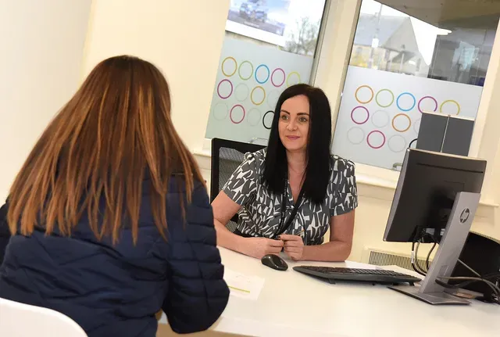
Scotland’s housing emergency, rising costs, and increasing bills deepen financial hardship and widen health inequalities. Reducing financial pressure is a vital health intervention, improving health and wellbeing outcomes for households.
Tackling poverty is central to Falkirk’s corporate priorities and is embedded in the Building a Fairer Falkirk strategy. Our approach aligns with national strategies to reduce inequalities and improve health by helping people increase income and lower living costs.
Our approach
Falkirk Council improves health and wellbeing by increasing household income through innovative, data-driven methods. A key focus is boosting take-up of Council Tax Reduction (CTR), which eases bills and acts as a gateway to wider support. Fluctuating earnings, common among carers, shift workers, and those in insecure jobs, can break universal credit entitlement risking missed support. To address this, the revenues and benefits team introduced an automated process that keeps CTR claims open for 10 weeks after eligibility ends. This allows quick reinstatement if earnings drop again, preventing gaps in support and reducing the need to reapply. This innovation has significantly increased CTR take-up and eased financial pressure.
Automation also identifies changes affecting entitlement to Discretionary Housing Payment (DHP) for the Under Occupancy Charge (‘Bedroom Tax’) and Benefit Cap. This allows automatic awards or updates without the need for repeated contact with households.
This proactive approach has resulted in a consistently high uptake rates of DHP for Bedroom Tax and Benefit Cap, relative to Scottish government estimates. A similar approach extends to Free School Meals and School Clothing Grants. Automation checks eligibility and removes the need for repeated contact. As entitlement is normally assessed annually, families were at risk of missing out on this vital support. This process reduces that risk.
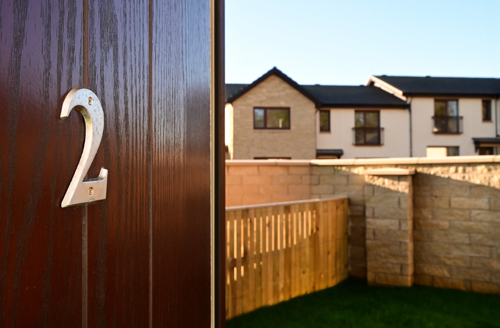
The council’s cash-first Household Support Fund, linked to CTR entitlement, provided flexible financial aid to thousands of vulnerable adults and children during a time of rising living costs. Over a third of households supported also received financial health checks, helping them access longer-term benefits.
Trusted frontline services, including advice and support hubs and the community advice service, offer benefit checks, money advice, and advocacy. These services have secured substantial financial gains for residents and reduced poverty-related stress. Alleviating hardship contributes to improved mental health and wellbeing, reducing stress, anxiety and depression. Collaboration with health and social care partners ensures a joined-up approach to supporting vulnerable households.
Targeted benefit awareness campaigns focus on families and older people, using digital platforms, direct outreach, and multilingual materials to improve benefit take-up.
The council has also invested in affordable, energy-efficient homes. In 2024/25, over 120 new homes were built, including family-sized, energy-efficient properties that reduce fuel poverty and improve living conditions. Ongoing investment ensures existing homes meet high standards and helps tenants lower energy bills.
Preventing homelessness is a key priority. Increased funding for the Homelessness Prevention Fund has helped families in temporary accommodation move into permanent homes, covering essential items and removal costs. These efforts reduce the trauma and health impacts of homelessness, especially for children.
By focusing on early intervention and reducing barriers to support, Falkirk Council prevents financial crises before they escalate. From automating benefit processes to investing in secure, energy-efficient housing, each action reduces stress, improves stability, and protects health. This preventative model strengthens wellbeing and reduces long-term demand on health and social care services.
Outcomes and achievements
- Increased Council Tax Reduction (CTR) take-up by 6.9 per cent between October 2022 and October 2024, the biggest increase in Scotland.
- Provided households with support worth £964k through the Household Support Fund, supporting over 5,600 adults and 4,000 children with flexible financial aid.
- Secured £16.6 million in benefit gains for residents via advice and support hubs and community advice services in 2024/25, up £3.7 million on the previous year.
- Visits to our advice and support hubs have increased. Reception staff supported 9,861 visitors and multi-skilled advisers helped 4,966 people, up from 8,539 and 4,022 in 23/24.
- Achieved 94 per cent take-up of the Scottish Child Payment, exceeding the national average of 89 per cent.
- Awarded additional school cost support pupils via automated eligibility checks.
- Ran targeted benefits awareness campaigns reaching over 33k people with more than 160k advert views.
- Boosted pension credit take-up increasing benefit gains from this support by £175k (198 per cent).
- Delivered 122 affordable homes, including 68 new builds and 54 homes bought back, supporting stable, energy-efficient housing.
- Achieved 82.7 per cent of council homes meeting the Scottish Housing Quality Standard and 96.3 per cent meeting energy efficiency standards.
- Supported 462 households in temporary accommodation, including 103 families with children, through the Homelessness Prevention Fund and Deposit Assistance Scheme.
Shortlisted entries
East Ayrshire Council - Connecting Housing and Tenants Visit (CHAT)
Application entry
- Project name: Connecting Housing and Tenants Visit (CHAT)
- Lead organisation: East Ayrshire Council
Statement of support
At East Ayrshire Council, we understand that good quality housing is more than just bricks and mortar; it is a foundation for health and wellbeing. Recognising the multifaceted challenges faced by our tenants, including poverty, social isolation and the lasting impact of trauma.
We strive to ensure that all tenants live in good quality homes, which are warm, safe and affordable in vibrant communities and in 2025 the housing service embarked on a transformative journey to enhance service delivery to enhance the quality of lives for our tenants, increase tenancy sustainment and protect our assets.
At a development day with stakeholders, it was acknowledged by all colleagues that it is crucial to engage meaningfully with all tenants regularly in order to explore any underlying causes of social and economic disadvantage and poor health outcomes, and through a coaching approach, help them to achieve their goals and aspirations in life.
We needed to be radical and to put tenants at the heart of service delivery and as a result, we took a transformational, collaborative approach which was creative, caring, and citizen-centred and the concept of a Connecting Housing and Tenants (CHAT) visit was borne.
A short-life working group which included representatives from the East Ayrshire Federation of Tenants and Residents, took forward a range of actions and following a successful pilot in three communities across the local authority, CHAT visits were fully implemented in April 2025 to all our tenancies.
Neighbourhood coaches carry out the CHAT visit which has a number of goals:
- Build and strengthen relationships with our tenants
- Maintain sustainable tenancies and proactive tenancy management
- Ensure the property is being maintained in accordance with the tenancy agreement
- Ensure appropriate levels of occupation
- Ensure the accommodation is suitable for the household e.g. if there was an emergency, that safe evacuation can happen
- Promote tenant health and wellbeing
- Identify any support needs within the household
- Check for any outstanding repairs, including dampness and mould, and that the property is safe and secure
- Identify how tenants would like us to communicate and consult with them
- Provide the opportunity to improve tenant profile information to support better tailoring of services
- Engage proactively with our tenants, let them know their views are important to us and that their satisfaction with us as their landlord is our priority.
New IT devices were provided to neighbourhood coaches, designed to elevate the efficiency and effectiveness of the CHAT visit, enabling identified actions to be instructed on-site, for example, a referral to Lemon Aid for energy advice or to housing asset services for a dampness inspection in the home, streamlining the process along the way and reducing officer time and duplication.
CHAT visits are now an integral function for the neighbourhood coaches who engage with tenants in relation to all housing and tenancy matters – rent arrears, estate management, tenancy management and tenant engagement and participation.
The neighbourhood coaches take time to build nurturing, trusting relationships with tenants and instead of reacting to tenancy breaches through an enforcement lens, the CHAT visit provides an opportunity to discuss matters in a safe, comfortable environment varying from income maximisation, help to look after the home and garden, promoting contents insurance and identifying the need for adaptations, taking a proactive approach to identify problems tenants are experiencing at an early stage.
CHAT visits are an excellent opportunity for neighbourhood coaches to focus on ensuring tenants are receiving all benefits to which they are entitled to to increase household income to reduce rent arrears and poverty within the home and maximise opportunities for children and young people to thrive in a healthy home.
The CHAT visit takes a trauma-informed approach to engaging with our tenants, recognising that quite often, a lack of engagement is due to challenges within the home such as mental health problems, social isolation, loneliness, self-neglect, hoarding and quite often, significant repairs needed in the home. By taking time to reaching out to tenants and establish a trusting relationship, neighbourhood coaches can identify complex support needs, enabling signposting to support services and community resources.
The CHAT visit has established a platform for upstream early intervention, enhancing tenants’ health and wellbeing. It has improved data collection in relation to aids and adaptations, saving time and resources when allocating homes and supporting tenants.
Outcomes and achievements
The improvements achieved by the introduction of CHAT visits have been significant.
Proactive, personalised CHAT visits allow for earlier identification of issues in the home, for example financial challenges, fuel insecurity, potential decarbonisation opportunities and social isolation and loneliness.
Integrating a trauma-informed approach to all interactions with tenants, recognising that experiences can significantly affect individuals’ housing needs and wellbeing, and building strong relationships, cultivating trust and rapport with tenants through caring conversations, listening to their concerns with empathy and understanding and providing practical advice and assistance on a range of issues had positively-impacted tenancy conditions and wellbeing in the household.
Identifying the areas to help tenants manage their homes has increased multi-disciplinary collaboration and created new, strong partnerships across the Council, Community Planning Partners and the third sector to link tenants into person-centred, holistic support for self neglect and hoarding issues.
- Neighbourhood manager, Carol McLelland comments:
“The implementation of CHAT visits and the data-driven insights has helped identify trends and address systemic housing and wider wellbeing issues and is an important tool to continuously improve service delivery. Through CHAT, housing services strive to improve efficiency, deliver high quality services and transform the lives of the people we serve.”
Case study
During the assessment of customer feedback, the CHAT pilot working group noticed a recurring theme in a particular street - tenants were experiencing uncomfortable drafts in their homes. Further investigation revealed these drafts were caused by poorly-sealed glazed windows, leading to lower-than-expected heat efficiency, higher energy bills and prolonged health issues.
Rather than treating each case individually, Housing Services decided to take a proactive, community-focused approach. They analysed data from the customer feedback system and collaborated with housing asset services to identify the affected properties.
A comprehensive survey was conducted to gather insights into the extent of the issue and its impact on tenants' comfort and energy consumption. The results confirmed the need for a collective solution. By coordinating with the housing improvement team and procurement, a bulk order for energy-efficient replacement windows was secured. This approach not only improved the energy efficiency of each home but also resulted in cost savings for both tenants and the council.
This was a resounding success. Residents on the street reported a significant improvement and they reported feeling healthier, safer and more comfortable in their homes.
Energy bills are reported to have decreased and residents expressed gratitude for the council's proactive approach. This was a fantastic example of early identification of an issue via the CHAT visit, exactly what housing services were looking to achieve in regard to improving the health and wellbeing of tenants.
West Dunbartonshire Council - Mount Pleasant
Application entry
- Project name: Mount Pleasant
- Lead organisation: West Dunbartonshire Council
- Partner organisation: CCG
Statement of support
Mount Pleasant is an affordable housing development for West Dunbartonshire Council, providing new homes for the over 55s who are looking to downsize. Designed to Housing for Varying Needs and Dementia Design guidance, homes support ageing in place and provide an inclusive community for residents. The development comprises nineteen homes within three blocks of flats, bungalows, and cottage flats arranged around a central community garden and resident car park.
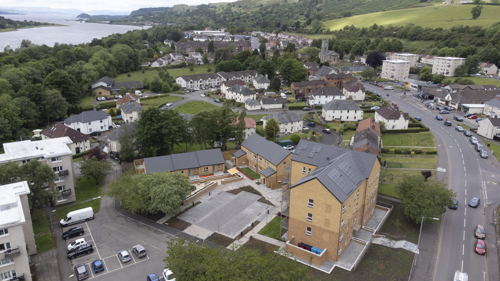
An inclusive community
The central garden is visible from each residential block and provides a focus and social hub for residents. It promotes sociability by providing choice. Residents can join in shared activities with their neighbours by joining in with gardening activities – the fully wheelchair accessible garden incorporates social seating surrounded by low level planting borders, used to grow flowers, herbs and vegetables plus a covered seating bench provides a sheltered space to sit during inclement weather.
Alternatively, if residents prefer to step back and observe activity (a preference for some people with dementia) they can sit at their front doors using a bench designed into covered front porches for bungalows, or chat informally across low-level boundary walls between rear gardens.
The local designing out crime officer was consulted throughout the design process, helping to identify ways to ensure the scheme felt safe and secure for the tenants, addressing issues related to overlooking and highly permeable boundaries through architectural interventions.
Interaction with nature
Anderson Bell Christie have completed research with the University of Edinburgh which highlighted how a visual connection to greenspace and nature has been proven to have a positive impact on wellbeing for older people, helping to reduce stress and improve mood and cognitive function. As the expected residents for the development are those over the age of 55, this was especially relevant. Each home is designed with large windows to provide high levels of natural lighting and excellent views to the central garden as well as the wider area, including the Kilpatrick Hills. Outdoor seating areas in the form of covered porches and projecting balconies enhance the connection to the external environment.
A central community garden
The central community garden provides opportunities to boost both physical and mental health. Low-impact exercise such as gardening has shown to increase strength and balance, as well as stress reduction and cognitive stimulation. The combination of physical activity and exposure to sunlight has also shown to improve sleep quality.
The garden has been established by a local voluntary organisation who have worked with the council and the new residents to select planting, which is low maintenance, and visually appealing, and also provides edible produce for the residents in the form of vegetables and herbs.
Greenspace at the heart of the development
The greenspace and landscaping strategy is closely linked with the health and wellbeing strategy. We worked closely with the landscape architect to create areas with different outdoor characters, such as private front gardens with benches, and communal planting and vegetable growing zones. These allow tenants to choose how to socialise and engage with one another. An aspect of dementia is that sufferers may lose confidence in speaking with others but might still want to sit out and observe neighbours gardening, for example. Different hierarchies of outdoor space give tenants the agency to choose their level of engagement at any given time.
Excellent ventilation
Natural ventilation is maximised within each home, and MVHR (mechanical ventilation with heat recovery) units ensure waste air is removed efficiently. Easily accessible external drying spaces are provided for each resident ensuring air quality and moisture levels within the properties are optimised.
Outcomes and achievements
This development prioritises residents’ health and wellbeing to create a resilient, sustainable and supportive neighbourhood for the over 55s by implementing sensitive design principles:
Excellence in design
Mount Pleasant was designed to West Dunbartonshire Council’s design guidance and complies with Housing for Varying Needs guidance for disabled and ambulant disabled residents across the various house and flat types. It also implements the principles of Designing for Dementia to ensure that the intended residents of over 55s can sustainably and comfortably age in place.
Landscaping as a catalyst for social interaction
The centrally placed community garden and various seating areas are key to fostering strong relationships within the new community and prioritises pedestrians.
Dementia design
Clear wayfinding and orientation devices such as colour coded front doors, planting boxes and clear signage across the development help to assist residents navigate with ease and feel comfortable in their new homes.
Tenant feedback
- "I am so happy in my new home, I was reluctant to leave my larger family home and garden in Dunbarton, however my new house is thoughtfully designed, I have a low maintenance private garden, and I am looking forward to meeting my neighbours around the community garden"
South Lanarkshire Council - Empowering residents through activity and inclusion
Application entry
- Project name: Empowering residents through activity and inclusion
- Lead organisation: South Lanarkshire Council
Statement of support
The team of sheltered housing officers (SHOs) not only provide practical housing support to residents including budgeting advice and tenancy management, they also promote wellbeing by facilitating access to personal services such as cleaning, podiatry, hairdressing and connecting with wider support services such as Health and Social Care.
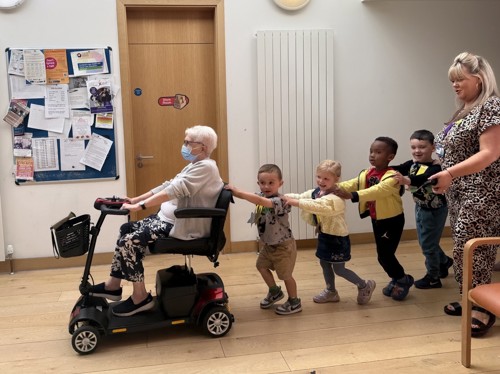
SHOs play a vital role in local communities, supporting a wide range of activities hosted within sheltered housing developments. These activities are not only accessible to those residing in the developments, but are open to and promoted within the surrounding neighbourhoods, to encourage wider community engagement. Most activities are tenant led, however, community groups are also actively involved in the sheltered housing service, running groups such as dementia cafes from the common areas. In addition, in some locations, weekly gatherings take place with neighbouring children’s nurseries, to foster connections across generations.
In the past year a range of new activities have commenced, including:
Friends Round Friday is a six weekly befriending group started by a SHO to encourage tenants, who don’t always want to join the more regular tenant’s groups such as the coffee club or bingo.
Every meeting has a different theme. The first week was bring something from your childhood to talk about. Tenants brought toys, souvenirs from holidays and mementos of their past. The items were great talking points as everyone was delighted to see photos of people who are now in their 80’s, as 10 year olds and pre-decimal money which sparked a lot of discussion around the old pound, shillings and pence.
The Friends Round Friday group has had a positive impact on many of the sheltered housing tenants who did not always engage in other activities. One such tenant was Mr C, who was always a quiet man, but became more withdrawn after suffering a stroke. Although Mr C would attend events when encouraged by carers, he usually said little. At one Friends Round Friday, the topic was vintage toys, and someone brought a View-Master toy with vintage reels of places around the world including the USA and Canada. Seeing the reels prompted Mr C to talk about summers he spent at Niagara Falls with his family. This was the first proper conversation Mr C had with the SHO and the other tenants in a very long time. Mr C now looks forward to attending and participating in as many of the Friends Round Friday events as he can.
The beautiful weather in June was too good an opportunity to pass up for the residents of one sheltered housing development, who decided to hold a ‘Potluck Picnic’ in their courtyard.
The group decided that ice lollies and garden games were a great way to see old friends and make some new ones. Invites included the ask to bring a small amount of food to share. Sandwiches and home baking were enjoyed, and the sheltered housing officer was there to supply the ice lollies and cold drinks. The garden was decorated with bunting and music was played for that garden party atmosphere, even graduating to a sing song at one point.
Things got competitive when the garden games were brought out. Garden darts was won by one resident, however, some said she had an advantage as she was a champion bowler back in the day and has a keen eye for a target.
Outcomes and achievements
South Lanarkshire Council proudly delivers an exceptional sheltered housing support service to over 1,200 tenants across four localities, encompassing a diverse mix of communal buildings, scattered sites, and community sites.
The sheltered housing service aims to:
- Provide an effective housing support service to tenants
- Enhance the wellbeing of tenants
- Support tenants to maintain their tenancy and live independently in their home.
A recent satisfaction survey reported that an outstanding 96 per cent of tenants reported being very satisfied or satisfied with the quality of support received.
Tenants commented:
- “The communal lounge is a great place for anybody to use who lives on their own to meet other people”
- “Sheltered housing has provided a safe, supportive living environment which I am extremely grateful for. The support I receive from my sheltered housing officer is exceptional”
At a recent visit to a sheltered housing development, local elected members engaged with tenants, saw the onsite amenities and the positive impact children visiting from a local nursery had on tenants. They expressed admiration for the exceptional quality of services and the meaningful, positive effect on tenants’ wellbeing.
South Lanarkshire’s sheltered housing service is a beacon of compassionate, person-centred support, fostering independence, community and wellbeing every day.
Renfrewshire Council - MyLA (My Life Ahead)
Application entry
- Project name: MyLA (My Life Ahead)
- Lead organisation: Renfrewshire Council
- Partner organisation: Turning Point Scotland
Statement of support
Launched in 2022 via funding from Renfrewshire’s Alcohol & Drug Commission, My Life Ahead (MyLA) is a housing- led project providing holistic wraparound support for those with substance and / or alcohol issues and living in unstable housing situations - with many at risk of losing their home.
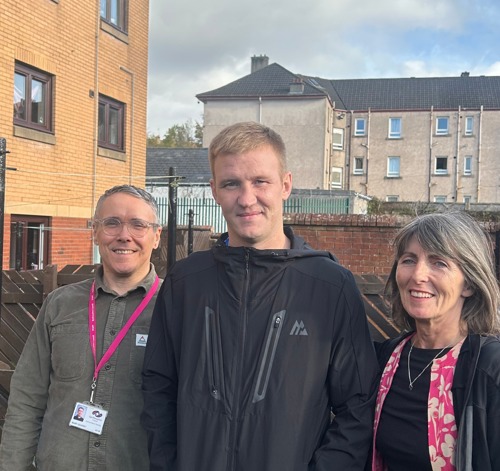
MyLA’s approach has been uniquely focussed on the belief that good health and recovery can be dependent on having good, settled housing, and the service deploys a trauma-informed approach, focussing on:
- Persistence
- Patience
- Consistency.
The team of three from the delivery partner, Turning Point Scotland, are compassionate, non-judgemental and understanding of the chaotic nature of many of their service users’ lives and the barriers they can face in sustaining settled accommodation and engaging with services. One member of staff is a peer worker with lived experience of substance use issues.
Staff regularly visit service users at their home or in the community, offering tailored help and support in a flexible way which best suits the individual.
Some examples of the types of support offered include:
- Meeting the requirements of their tenancy agreement, e.g. managing rent arrears and addressing anti-social behaviour
- Linking people in (or back into) specialist addiction and counselling services
- Advocating for service users
- Help to register, arrange and attend GP and mental health care appointments
- Linking in with other agencies or services (including Foodbanks, community and wellbeing groups, banking services)
- Emotional support and spending time with service users who face social isolation
- Maximising income and supporting people to furnish their homes.
Support continues until agreed outcomes have been met or service users feel they no longer require help from MyLA. Importantly their case can be quickly reopened if their circumstances alter.
There is a high demand for MyLA - over 200 referrals since the launch, and meaningful support provided to 89 households, with 28 current open cases.
The involvement of staff with lived experience has been beneficial in helping to build trust and rapport, making service users feel understood and accepted. A service user says:
- “The two of us, we get on well. She listens. I told her my life story. She’s chatted about her previous life and what she went through and all that. And that’s why I ended up opening-up about what I went through”.
MyLA has a strong focus on collaboration with other services to provide more comprehensive support for service users. Strong relationships have been established with other agencies including the council’s anti-social behaviour team, housing and homeless services, mental health and addictions services, and various third sector organisations.
In addition, MyLA was instrumental in the establishment of a Complex Cases Working Group which meets every six-weeks, with representatives from housing, Community Mental Health, Addiction Service and Social Work teams meeting regularly for the first time to share information and discuss / agree how the needs of this particularly vulnerable group of people can be met. The group has been invaluable in generating faster referrals, reducing delays in accessing support and quicker interventions when MyLA service users are not engaging or in crisis.
MyLA helps to prevent the escalation of problems and subsequent involvement of other public services, including mental health services, social work and the criminal justice system. This has helped to alleviate pressures on other local services, saving time, resources and money.
An independent evaluation of MyLA for Renfrewshire’s Alcohol & Drug Commission earlier this year concluded the MyLA project has successfully delivered holistic, wraparound support to individuals with complex needs relating to substance use and housing precarity.
Outcomes and achievements
Alcohol and drug use:
- Early intervention with health issues and crisis situations - no drug deaths since MyLA began
- Reduction in drug / alcohol use
- Significant success with opioid replacement treatments - transition from methadone to opioid blockers has been a hugely positive step with reported improvements in service user’s mental health and long-term recovery ambitions.
Settled housing:
- Evictions have been eliminated
- MyLA has assisted service users to apply for funding to furnish their homes- over £30,000 of successful Community Care
- Grant Applications
- 20 service users reduced their rent arrears and 64 received foodbank parcels in last 12 months.
Extract from independent evaluation:
- “By delivering flexible, person-centred support in a trauma informed way, staff have built trust and rapport with service users, which has led to a number of positive outcomes…the project has been successful in stabilising many individuals’ housing situations and has contributed to improving the quality of life and health and wellbeing of its service users. The service users consulted expressed gratitude for the continuous support from MyLA and highlighted the positive impact it has had on their life”.
Service user feedback:
- “Honestly, if I didn’t have MyLA, I think I would probably be gone by now”
River Clyde Homes - Financial Wellbeing Team
Application entry
- Project name: Financial Wellbeing Team
- Lead organisation: River Clyde Homes
Statement of support
River Clyde Homes – Financial wellbeing service
At River Clyde Homes, we believe that supporting our customers goes far beyond providing safe and secure housing. Our financial wellbeing service exemplifies our commitment to being more than just a landlord—by helping customers navigate financial challenges and improve their overall wellbeing.
Led by a team of three dedicated and highly skilled officers, the service has historically operated on a reactive basis, responding to referrals from frontline teams or direct customer contact. This approach has been vital in supporting customers at crisis points, generating over £3.8 million in financial gains annually through welfare benefits and income maximisation.
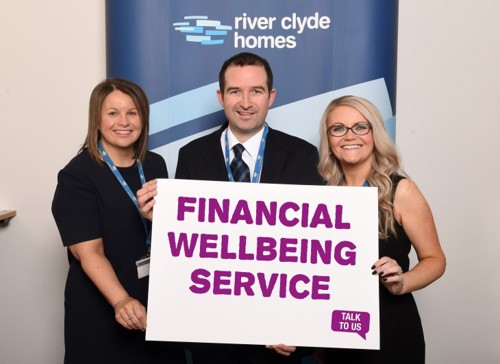
Serving communities in Inverclyde which, according to the SIMD data in 2020, has some of the most deprived neighbourhood areas in Scotland, makes this service vital for our customers and their families.
In the past year, the team has transformed the service into a proactive model that anticipates customer needs before they reach crisis. One standout initiative targets customers approaching pension age, a time of significant financial transition. By reaching out early, the team ensures customers are informed, prepared, and supported—making the process seamless and stress-free.
This proactive ethos now runs through everything the team does. Seasonal social media campaigns and an annual ‘Money Matters’ magazine, delivered to all customers, remind people to apply for key supports such as school clothing grants, winter fuel payments, and other entitlements—prompting self-referrals and ensuring no one misses out.
The team are also continuously seeking opportunities to enhance the support provided for customers such as funding opportunities. This year, RCH alongside other local housing association partners, were successful in a bid to provide fuel support and advice for customers - a service that will be vital this winter for our customers.
The team has also played a crucial role in supporting customers through the universal credit transition, a process that can be daunting for those furthest removed from services. By prioritising early engagement and clear communication, they’ve helped customers feel reassured and informed.
In the last year alone, the financial wellbeing service supported nearly 900 customers, delivering over £3 million in financial gains—a testament to their impact, innovation, and unwavering commitment to customer wellbeing.
Outcomes and achievements
- £3.8 million in financial gains generated for customers in 2024/25
- 790 customers supported with over 1,300 welfare benefit related matters
- 850 successful claims for welfare benefits made
- 40 benefit decisions formally challenged for customers
- Over 5,000 households supplied with a free advice magazine
- Over 40 outreach activities held within our communities to increase awareness of the service.



